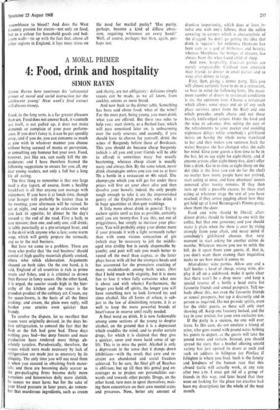One man's meat
CONSUMING INTEREST LESLIE ADRIAN
My first lesson in how to get blotto was learned in a northbound tuts railway carriage, invaded during the very small hours of a war-time morn- ing by some kilted soldiery. Their knapsacks appeared to contain nothing except bottles and beakers, with whose aid they hospitably in- ducted me, a consenting non-adult, into the Nordic rite of alternating neat spirits and beer chasers. This is beyond doubt the quickest alco- holic route from sobriety to insensibility, and on that particular journey Lethe is the only river I could swear to having crossed between the Thames and the Clyde. Considering how I felt for the next several days, it has always shocked but never surprised me that mortality in Scotland from cirrhosis of the liver is up to double the English rate each year.
What does surprise me is that Scotland should also prove such a habitat of `carboholics'—of people, that is to say, with a rabid craving for starches and sugars, particularly sugars. When I pontificated in this column a year ago on how bad confectionery was for British waistlines, complexions and teeth, I had no idea what a disproportionate swipe I was taking at the Scot- 'Well at least it's spared us all those photographs of Harold Wilson in shorts and sandals.' tish economy or the Gaelic way of life. There are many more sweet shops in Scotland than anywhere else in Britain and the amount spent in them is twice the English level. Indeed, whether measured by their consumption of chocolate biscuits or cherry brandy, the Scots are sweet-toothed to a degree that far exceeds anything known south of the Border.
Lest separatist conclusions be too hastily drawn from these facts, it should be pointed out that such discrepancies between Scotland and England have well documented counterparts in other regions of the United Kingdom. Those announcements on strike-struck rrv, saying that commercials were being transmitted on the national network and apologising if certain items weren't available in your area, at least partially contradicted the supposed homo- geneity of the mass-consumption society. But actual availability of brands lacks the conclu- siveness provided by relative popularity of products. Brown bread, for example, is eaten everywhere, but in the Tyne-Tees area they eat twice the national average. Butter is generally spread on brown and white alike, but nowhere to the same colossal extent as in Wales.
Regional variations over a wide range of foods have remained remarkably consistent since the National Food Surveys began to be analysed geographically, and they have prob- ably stayed that way much longer. Certainly Mr David Elliston Allen, who has recently con- cluded an investigation, going far beyond food and drink, into the preferences of the regional consumer, feels justified in drawing material from a considerable time span as well as an astonishing variety of sources. Thus Odhams's unpublished consumer surveys of 1960 on home baking and home jam-making rub shoulders with Captain Topham's Letters from- Edinburgh, Written in the years 1774-1775. and some re- marks in this column on the prevalence of pre- war demand for peppery sausages keep com- pany with an article in the Eugenics Review on the incidence of the hereditary inability to taste phenylthiocarbamide.
The author of British Tastes (Hutchinson 45s) has worked in market research for ten years, and his compilation is addressed in the first instance to advertising men and sales repre- sentatives. But what he feels impelled to pass on to them is based quite largely on his aca- demic training in anthropology and sociology, and it is this which gives his clever and readable book its wider interest and controversial ele- ment. For basically what he is saying is that, while regional surroundings may change, the regional personality stays obstinately fixed— relatively unswamped by internal migration and apparently impervious to commercial bludgeoning. 'Basic tastes remain the same.... The notion of rapid and continuous change in anything but superficial respects arises in part from an optical illusion, in part from a profes- sional myth of the marketing fraternity.'
This is strong stuff, and neither the market- ing fraternity nor the regions themselves are likely to assent to all the book's analyses and tentative explanations of deep-seated conserva- tism in likes and dislikes. Bustling Londoners, singing 'Let's all go down the-Strand,' may well regard the banana as their special fruit because it is a 'superbly unzippable time-saver.' But is asparagus deeply disdained by York- shiremen because it is an alien frippery out of keeping with their 'fortress personality' and no-nonsense approach? Could the 'symbol- orientated' Lancastrians conceivably steer clear of tomatoes in liquid form on account of their
resemblance to blood? And does the West Country passion for cream—not only on food, but as a colour for household goods and bed- room walls—tie up with the fact that, above all other regions in England, it lays most stress on the need for marital purity? 'Has purity, perhaps, become a kind of diffuse obses- sion, requiring whiteness on every hand?' Well, of course, perhaps; but then, again, per- haps not.



































 Previous page
Previous page